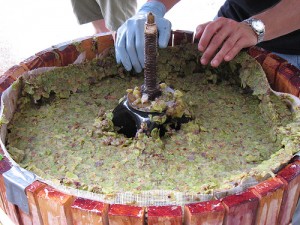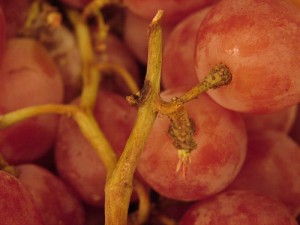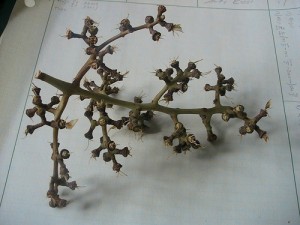In this age of changing climate, there is an ever present push to find more ways to be more environmentally friendly and sustainable in all industries and settings. If you’re at all familiar with the content here on The Academic Wino, you’re probably already well aware of the fact that the wine industry is no different in regards to this quest for sustainability. To be specific, there have been quite a large number of studies now at this point examining the utilization
of wine industry waste into other functional products, instead of simply discarding the waste to wreak havoc on the environment.
Though there are certainly more studies than I have been able to present on this blog, here are some examples of what has been done so far in regards to utilizing wine industry waste:
- Grape Residues or Pomace as a Meat Preservative?
- Grape Residues as a Nutrition Booster for Hot Dogs?
- Winery Wastewater and Animal Manure: The New Alternative Fuel Source
- Grape Pomace: The Diabetes Wonderdrug
- Wine Industry Waste as Protein Supplement for Tilapia Feed Diets: Rice Wine Edition
- Infusions of Grape Skins to Green Tea Increase Overall Health Benefits; Including Antiviral Activity Against Influenza
- Using Grape Seed Extract in Beef Patty Marinades: Evidence for the Reduction of Carcinogenic Compounds in Red Meat
- Using Dehydrated Grape Marc Waste to Improve Wine Quality: A More “Natural” Approach?
- Enzymatic Extracts from Wine Industry Waste May Provide Cardiovascular Benefits in the Rat Model
As you can see from just the headlines of these posts, there have been many applications examined for wine industry waste in nearly every possible use imaginable. Most research to date has focused primarily on the grape pomace (a.k.a grape marc), which is made up of the leftover skins and seeds of the grapes after pressing. One major source of wine industry waste that has been examined very little is the grape stems. Prior to pressing, during the sorting process, stems are separated from the grapes and discarded. To date, very few studies have examined what, if any, nutritional value these stems have, and can they be utilized for other purposes instead of being discarded and adding to the significant environmental issues associated with industry waste.
The study present to you all today aimed to add to the small list of literature
related to the utilization of grape stems by examining their antioxidant activity and the possible applications for their use as natural antioxidants for the betterment of human (or animal) health.
Methods
Grape stems were supplied by the Spanish winery, Antonio Nadal S.L., Mallorca. Stems were collected from the Vitis vinifera grapes, Manto Negro (red) and Prensal Blanc (white). Stems were collected during the destemming process and prior to grape pressing.
Stems were dried, ground, and stored at -20oC until ready for use. Ground stems were prepared into extract using acetone and also ethanol (two separate extracts). There were a total of 4 extracts tested: 1) red grape stems with acetone; 2) red grape stems with ethanol; 3) white grape stems with acetone; and 4) white grape stems with ethanol.
The following were measured and analyzed in stem extracts: total polyphenols, flavanols, and antioxidant capacity.
Results
- The author reports high polyphenolic concentrations in all grape stem extracts.
- Total polyphenol concentrations were higher in red grape stem extracts than white grape stem extracts.
- Grape stem extracts prepared with acetone had higher concentrations of total polyphenols than grape stem extracts prepared with ethanol.
- Concentrations of flavanol were higher in red grape stem extracts than white grape stem extracts (same pattern as with total polyphenols).
- Grape stem extracts prepared with acetone had higher concentrations of flavanols than grape stem extracts prepared with ethanol (same pattern as with total polyphenols).
- Flavanols made up 70% of the total polyphenol content of the grape stem extracts.
- The author reports high antioxidant capacities in all grape stem extracts, with the red grape stems extracts having higher antioxidant capacities than the white grape stem extracts.
- Antioxidant activity was significantly correlated with total polyphenols and flavanols.
What does this all mean?
Overall, this study found that red grape stem extracts prepared in acetone have the higher levels of total polyphenols, flavanols, and antioxidant capacities than all other extracts. The authors stated that all four extracts had high levels of these three things, though if one were to create a hierarchy of what is contains the highest to lowest levels (keeping in mind the low levels are still relatively high), it would be the following: red grape stem extracts with acetone > red grape stem extracts with ethanol > white grape stem extracts with acetone > white grape stem extracts with ethanol.
This was a very simple study that showed straightforward results (i.e. none of their results contracted one another and were similar to those of other studies). However, I would have liked to see them compare the grape stem extracts with
grape seed extracts, grape pomace extracts, grapes themselves, and finished wine. The authors claim that the total polyphenol and flavanol levels as well as antioxidant capacities of all the grape stem extracts were high; however, they didn’t have any type of control to prove it.
I am guessing that they were comparing the levels they found in their grape stem extracts with the levels found in the literature, however, I know from experience that comparing your numbers directly with the numbers of another study may be problematic, as there are almost always differences in regards to methods or individual researcher techniques that may alter the results from study to study. I would be more confident in the results had there been a control to which they were comparing.
Assuming the analysis is correct, it seems as though grape stems may be potentially useful as supplements benefitting human health, or potentially other applications that utilize products high in total polyphenols or antioxidant capacities. By recycling the entire grape and not just the skins and seeds, the wine industry may come one step closer to being more sustainable and friendlier to the environment than ever before.
Source: Llobera, A. 2012. Study on the Antioxidant Activity of Grape Stems (Vitis vinifera). A Preliminary Assessment of Crude Extracts. Food and Nutrition Sciences 3: 500-504.



